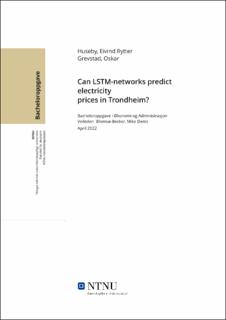| dc.contributor.advisor | Blomsø-Becker, Mike Denis | |
| dc.contributor.author | Huseby, Eivind Rytter | |
| dc.contributor.author | Grevstad, Oskar | |
| dc.date.accessioned | 2022-06-11T17:19:44Z | |
| dc.date.available | 2022-06-11T17:19:44Z | |
| dc.date.issued | 2022 | |
| dc.identifier | no.ntnu:inspera:108384214:110195170 | |
| dc.identifier.uri | https://hdl.handle.net/11250/2998402 | |
| dc.description.abstract | I denne bacheloroppgaven i økonomi og administrasjon skal vi undersøke hvor vidt long-short-term-memory neurale nettverk kan brukes til å forutsi moregndagens strømpris i Trondheim. Dette basert på prisen på naturgass, kullpriser, nedbør målt i Bykle og Glomfjord, temperaturen målt på Værnes, vekslingsraten mellom Norske kroner og Amerikanske dollar og vekslingsraten mellom Norske kroner og Euro
Vi forsøker å prediktere morgendagens strømpris i Trondheim ved å se på de foregående 30 og 50 dagene, samt en dag i forveien. Vi forsøker å gjøre dette ved å benytte alle variablene nevnt over som uavhengige variabler, og ved å kun bruke historisk strømpris som uavhengig variabel til å forutsi morgendagens strømpris. Modellen lærer ved å minimere det gjennomsnittlige kvadrerte avviket i treningsfasen, for så å validere læringen mot et sett med valideringsdata. Dette med mindre variablene kun inneholder støy og ikke utgjør noen nyttig funksjon for modellens evne til å produsere gode forutsigelser.
Gjennom undersøkelser og testing har vi funnet indikasjoner på at modellens evne til å predikere blir bedre ved å redusere antall variabler og dager som benyttes i beregningene. Det er for øvrig lite sansynlig at et LSTM-nettverks evne til å forutsi verdier bedres ved reduksjon av variabler og antall dager som inkluderes som input til modellen.
Basert på disse funnene kan vi konludere med modellen vår ikke er i stand til å produsere pålitelige resultater basert på de uavhengige variablene valgt i denne oppgaven. Vi ser også gjennom disse undersøkelsene tegn til at strømprisen kan betegnes som en random-walk tidsserie. | |
| dc.description.abstract | In this bachelors thesis in economics and administration we are investigating whether long-short-term-memory neural networks can be used to predict the price of electricity in Trondheim one day in advance. To make these predictions we are using the price of natural gas, price of coal, precipitation measured in Bykle and Glomfjord, temperature measured at Værnes, the exchange rate between NOK and USD, and the exchange rate between NOK and EUR.
To predict tomorrow power price, our research includes predictions based on the prior 50 and 30 days, as well as predictions based only the day before. We are doing this with all the variables mentioned over as independent variables, as well as separate predictions only using the historical electricity price to predict tomorrows price of power. Our model is learning by minimizing the the mean squared error of the predictions in the learning phase, and then validating the learning process with a set of validation data.
Through our research and testing we have found signs indicating that our models predictions improve when we reduce the amount of variables and days included in the prediction. It is not likely for an LSTM-network to be able to provide better predictions with less variables and time steps as the input, unless the variables chosen only contain noise. In that case, the addition of more variables with more noise would only prevent the models ability to produce reliable predictions.
In conclusion we can conclude that our model is not capable of producing reliable predictions based on the chosen set of independent variables. Through our testing we have also seen tendencies indicating that the power price could be subject of random-walk theory. | |
| dc.language | eng | |
| dc.publisher | NTNU | |
| dc.title | Can LSTM-networks predict electricity prices in Trondheim? | |
| dc.type | Bachelor thesis | |
